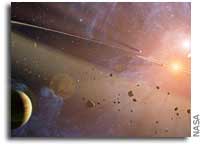Origin of Water in the Inner Solar System

There is a long-standing debate regarding the origin of the terrestrial planets’ water as well as the hydrated C-type asteroids. Here we show that the inner Solar System’s water is a simple byproduct of the giant planets’ formation.
Giant planet cores accrete gas slowly until the conditions are met for a rapid phase of runaway growth. As a gas giant’s mass rapidly increases, the orbits of nearby planetesimals are destabilized and gravitationally scattered in all directions. Under the action of aerodynamic gas drag, a fraction of scattered planetesimals are deposited onto stable orbits interior to Jupiter’s. This process is effective in populating the outer main belt with C-type asteroids that originated from a broad (5-20 AU-wide) region of the disk.
As the disk starts to dissipate, scattered planetesimals reach sufficiently eccentric orbits to cross the terrestrial planet region and deliver water to the growing Earth. This mechanism does not depend strongly on the giant planets’ orbital migration history and is generic: whenever a giant planet forms it invariably pollutes its inner planetary system with water-rich bodies.
Origin of water in the inner Solar System: Planetesimals scattered inward during Jupiter and Saturn’s rapid gas accretion
Sean N. Raymond, Andre Izidoro
(Submitted on 5 Jul 2017)
Comments: Icarus, in press. Blog post about the paper at this https URL Movie of simulation at this https URL
Subjects: Earth and Planetary Astrophysics (astro-ph.EP); Solar and Stellar Astrophysics (astro-ph.SR)
Cite as: arXiv:1707.01234 [astro-ph.EP] (or arXiv:1707.01234v1 [astro-ph.EP] for this version)
Submission history
From: Sean Raymond
[v1] Wed, 5 Jul 2017 07:07:06 GMT (3337kb,D)
https://arxiv.org/abs/1707.01234
Astrobiology








